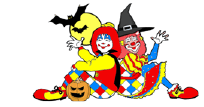A Brief Walk Through Clown History
In the last blog on this series we talked about the Egyptian Empire and that it was the first recorded instance of clowning.
Believe it or not, it wasn't until roughly 1,000+ years later that clowns were mentioned again in historical writings.
For today, we will be visiting Ancient Rome! To many historians this is where the modern idea of clowning truly birthed. We could very easily write an entire book on Roman Clown history, but for the purposes of this blog we will scratch the surface.
The Four Types of Clowns in Ancient Rome
1. Sannio

They were a popular type of mime and famous for their ability to pull hilarious grimaces with their faces and body. It follows that this clown, unlike most others of this time, did not wear a mask.
2. Stupidus

Stupidus (hence our word stupid) which was Latin for mimic fool.
The Stupidus was usually bald headed or wore a long pointed hat and a multi-colored outfit (Sounds like the ancestor of the Harlequin!).
This type of clown was famed for using innuendo and riddles and the ability to rain down blows on his fellow performers in burlesque fights in typical slapstick fashion. In true clown style, he used scandals of the day for his material and nothing was too sacred or sacrosanct to be the focal point of his humor.
To be quite honest, this type is perhaps my most favorite of all!
3. Scurra

The Scurra clown was a lower class of clown (kind of like the hobo clown in today's hierarchy). This is also where we get the word scurrilous from. Usually a person with a physical abnormality or mental illness.
The Scurra Clown indulged in jesting, his physical oddities setting him apart from his better class colleagues. Using his odd traits to win laughs from others. Truly humble people with thick skins for sure.
4. Moriones

Moriones (where we get the word moron) were not necessarily mentally challenged. Although they definitely were able to play it off.
It was common for the Great Houses and the Courts to keep freaks and fools (who on the whole were treated kindly) for entertainment. It was thought by many that they were endowed with special powers from the Gods and were treated as good luck charms.
During the Festival of Saturnalia, which marked the shortest day and the rebirth of life, a lowly slave would be chosen to take the place of the master of a household and for the duration of the Festival, he would “rule” the household. This is the origin of the “Lord of Misrule” tradition at the Medieval Christmastide.
All of which can be traced to the job of the Moriones clowns.
Conclusion
We can easily see, just by looking at the four types of clowns in Ancient Rome, that the idea of a clown hierarchy was developing and that certain skills and traits we see in clowns today somewhat reflect that of the clowns in Ancient Rome. We can also see the birth of the circus clown, as Ancient Rome was the beginning for that as well.
Stay tuned as the next step we go is just right around the corner in history. Ancient Greece is next!

2 comments
trojan horse next…. keep thinking on those same lines, but the “joke” is on the real clowns. You know the ones who pretend like they’re able to put man in a box, yeah those. That man is actually a lion because she doesn’t have to play pretend and hide behind a mask of sorts. The Divine Comedy cometh and the tragedy.
thank you for posting about this ancient history. I enjoyed your article.
One thing though, I don’t think you should have a picture of Joseph Grimaldi as “stupidus” in Rome (shown above) since he performed in the early 1800’s in England. …maybe you were just trying to bring an image across in the middle of the article, but since he is the “Father of Modern Day Clowning”…I would recommend a different picture for your article.